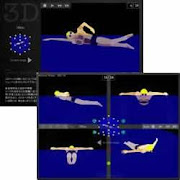 Michal Skrodzki brings us a pre-race report of the 1.2K Lorne Pier to Pub race in Victoria, Australia. Organized by the Lorne Surf Life Saving Club, 4,300 swimmers are cheered on by 15,000 spectators on a tiny beach hamlet of Lorne, 150K from Melbourne.
Michal Skrodzki brings us a pre-race report of the 1.2K Lorne Pier to Pub race in Victoria, Australia. Organized by the Lorne Surf Life Saving Club, 4,300 swimmers are cheered on by 15,000 spectators on a tiny beach hamlet of Lorne, 150K from Melbourne. The Pier to Pub race is featured on major news channels in Australia while Triple M broadcasts its radio program all day from the Pier to Pub with many local sports, political and TV celebrities making cameo appearances through out the day which include sporting stars, politicians and TV stars.
Swimmers in the SharkBait category (those who have swum the race more than 10 times or more) are given a priority in the entry submission. The race is split into many waves and in age categories. As Michal reports – and what our open water swimming community can appreciate – “Most people don’t enter to win but rather to conquer the course and achieve personal goals and to be able to tell their friends that they have swum the Pier to Pub. Many race their friends, family or just try to beat their time from last year and most end up at the famous pub after the race! The Lorne Pier to Pub encompasses all that is good about sport: fun, fitness and friendship are all main themes of the day.”
 For the competitive swimmers, the main race begins in the mid-afternoon when the elite SuperFish category takes off (see video below). According to Michal, this year’s race may be between the pre-race favorite and 2005 champion Nick Cordner, John Van Wisse, Sam Hume, Tristan Read and Leigh Ryan among the men. On the women’s side, Harriet Brown is the pre-race favorite with Holly Burton and Emera Galletly expected to be in the running.
For the competitive swimmers, the main race begins in the mid-afternoon when the elite SuperFish category takes off (see video below). According to Michal, this year’s race may be between the pre-race favorite and 2005 champion Nick Cordner, John Van Wisse, Sam Hume, Tristan Read and Leigh Ryan among the men. On the women’s side, Harriet Brown is the pre-race favorite with Holly Burton and Emera Galletly expected to be in the running.Upper photo by Getty Images. Lower photo by Justin McManus of the The Age.




















5 comments:
What's the water temperature? Lotta wetsuits, but paddlers not bundled up. Just curious.
I will check with our colleagues today. But, this calls to mind the difference in how the sport of open water swimming is being developed around the world. As the sport continues to grow and develop very quickly in countries like England, Australia, South Africa and elsewhere, there appears a push to include as many participants as possible regardless if the swimmers wear wetsuits or not. The strategy of British Swimming is particularly interesting and forward-looking, as they are focusing on a major celebration of open water swimming at the 2012 London Olympics.
I haven't been reading 10Kswimmer long enough to know how you and your readers feel about wetsuits. I'm totally against them for reasons which have nothing at all to do with thermal comfort. When "swimming" in a wetsuit, one can bend one's knees and raise the heels in the air and swim with the legs at a 90 degree angle to the water, and scarcely lose any velocity. It becomes actually difficult to kick -- the leg buoyancy interferes with the propulsive downstroke. Thus, strong kickers (e.g. Larsen Jensen/Erik Vendt-types) are disadvantaged. Weak kickers and, of course, triathlete-type weak swimmers, with imperfect body position, are unfairly advantaged. It just changes the dynamics swim competitions. The other problem is that, owing to buoyancy and higher body position and decreased resistance, it is always faster for sub-elite swimmers to swim in a wetsuit than without one, so even good (albeit sub-elite) swimmers are compelled to wear them, for the sake of being competitive, which, for many, greatly diminishes the aesthetic pleasure of swimming.
Many masters swimmers, channel swimmers and purists feel at least as strongly as you do about the use of wetsuits.
At the same time, hundreds of thousands of individuals worldwide have enjoyed open water swimming due to the use of wetsuits. This website provides information that is of potential interest to both groups.
From one perspective, I know that the current rules of channel swimming will not change in our lifetimes. That is, no wetsuits or even full-body high-tech suits will be allowed.
From another perspective, these no-wetsuit rules will not stop the relentless growth of wetsuit-wearing open water swimmers.
When I think fundamentally what is "fair" or not, it reminds me that today's athletes have advantages over athletes in the past. For example, contemporary athletes are aided by GPS that allows for ease of navigation and international jet travel.
It would be interesting to hear the opinion of purists in other sports (like mountain climbing) about the use of new technology in their sports. For example, I believe contemporary climbers use different technologies than when Sir Edmund Hillary climbed Mt. Everest.
Hello Larry,
Sorry for such a late reply but I only now read the comments.
The race is in the south is Australia near Melbourne. Water temp for the race annually is about 16-18 degrees, not that cold but not that warm either. Traditionally wetsuits were worn back in the day to keep you warm, but then the wetsuit companies decided to exploit this and create "speed suits". I am agaisnt wetsuits but I wear one because basically I am young and competitive! Anyway if you were to go to a race in the northern states such as NSW or Queensland you would see few wetsuits if any at all. It's just the way things developed over the years in Australia. And of couse all the official Swimming Australia open water races ban the use of wetsuits according to FINA rules.
Anyway hope that clears things up!
Michal Skrodzki
Post a Comment